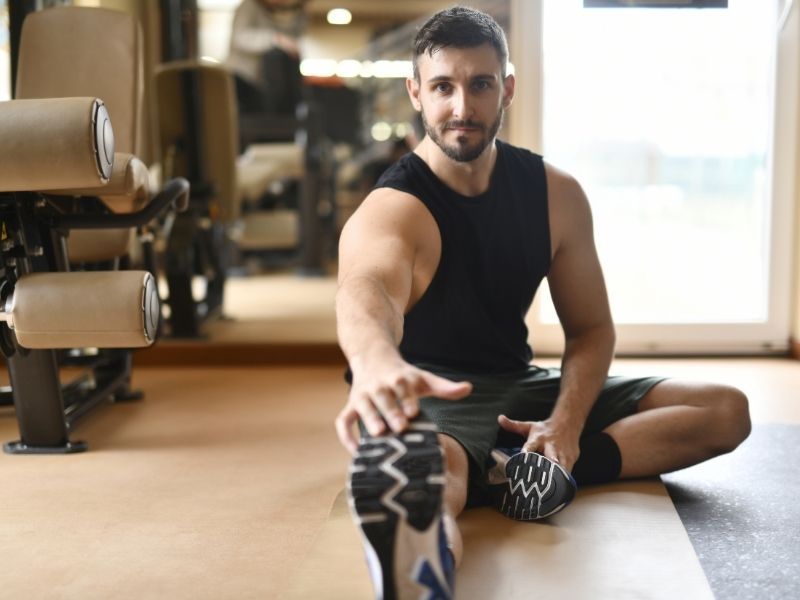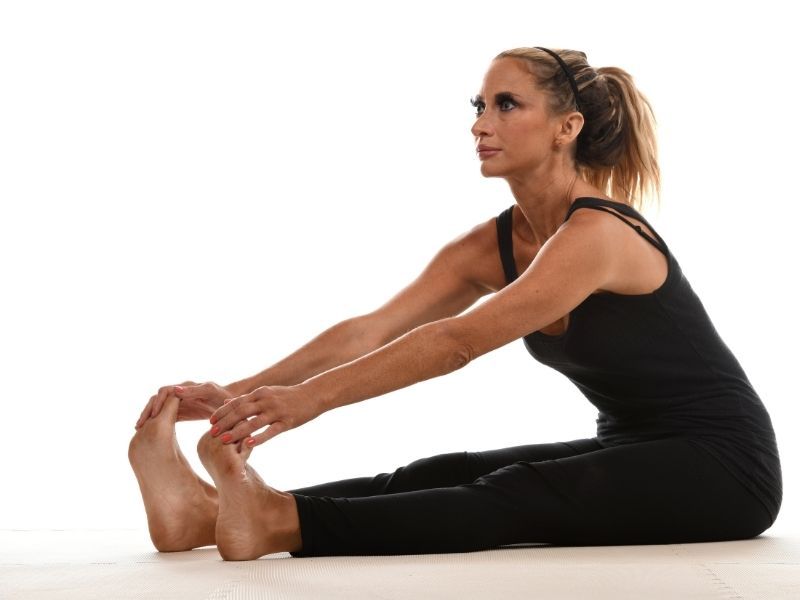Psoas Stretching And Strengthening | Restore Psoas Muscle Health

The psoas muscle, located deep within the abdominal cavity, plays a crucial role in our body’s movement and stability. However, due to our sedentary lifestyles and perhaps prolonged sitting, the psoas muscle often becomes tight and weak, leading to various musculoskeletal issues.
This raises the question: why should we prioritize stretching and strengthening our psoas muscle?
Some may argue that stretching and strengthening the psoas muscle is unnecessary, as they believe that our bodies naturally adapt to any imbalances. However, research has shown that a tight and weak psoas muscle can contribute to lower back pain, hip dysfunction, and poor posture. Therefore, it is crucial to restore and maintain the health of our psoas muscle through appropriate stretching and strengthening exercises.
In this article, we will explore the importance of psoas muscle health and provide a comprehensive guide on the best stretches and exercises to restore and strengthen this vital muscle. By incorporating these techniques into our daily routine, we can alleviate pain, improve mobility, and enhance overall musculoskeletal function.
[lwptoc]
Key Takeaways
– Sedentary lifestyles and perhaps prolonged sitting can cause the psoas muscle to become tight and weak.
– Stretching and strengthening the psoas muscle is important for restoring and maintaining its health.
– The psoas muscle plays a crucial role in movement, stability, and posture.
– Specific movements, such as the Thomas Stretch and Kneeling Hip Flexor Stretch, can effectively stretch the psoas muscle, while exercises like Supine Leg Sliders and Quadruped Leg Slide With Cable can strengthen it.
How does the psoas muscle work?
The psoas muscle, also known as the iliopsoas muscle, works by connecting the lower spine to the upper thigh, facilitating hip flexion and contributing to core stability.
As a key hip flexor, the psoas muscle plays a crucial role in the movement of the legs and torso. It works in conjunction with other muscles to allow for activities such as walking, running, and climbing stairs.
Additionally, the psoas muscle helps maintain proper posture by stabilizing the lower back and pelvis. When the psoas muscle is weak or tight, it can lead to imbalances in the body, causing issues such as lower back pain and compromised posture.
Strengthening exercises for the psoas muscle can help restore its health and function, promoting better overall body mechanics.
Why should you stretch and strengthen your psoas?
Improving flexibility and building strength in the muscles that connect the lower spine to the thighs can contribute to overall physical well-being and enhance physical performance.
The psoas muscle, which is located deep within the abdomen, plays a crucial role in hip flexion and is responsible for maintaining proper posture and stability.
Stretching and strengthening the psoas muscle can help alleviate tightness and improve its function. Tightness in the psoas can lead to a variety of issues, such as limited range of motion, lower back pain, and excessive anterior pelvic tilt.
By incorporating specific psoas exercises into a regular exercise routine, individuals can both stretch and strengthen this muscle, promoting improved coordination, increased flexibility, and enhanced muscular function throughout the body.
The best psoas muscle stretches
In the discussion on the best psoas muscle stretches, two effective stretching techniques that can help improve the flexibility and health of the psoas muscle are the Thomas Stretch and the Kneeling Hip Flexor Stretch.
The Thomas Stretch involves lying on your back while pulling one knee towards your chest, which helps to elongate and stretch the psoas muscle.
On the other hand, the Kneeling Hip Flexor Stretch requires kneeling on one knee while pressing the hips forward, providing a deep stretch to the psoas muscle as well as the other hip flexors such as the Rectus Femoris and TFL.
Both of these stretches target the psoas muscle and can be beneficial for its overall health and function.
Thomas Stretch
To enhance the flexibility and strength of the psoas muscle, the Thomas Stretch is a valuable stretch that involves:
– Sitting at the edge of a massage table
– Engaging the abdominal muscles
– Gradually leaning back while drawing the knees towards the chest, then allowing one knee to lower until a stretch is felt in the front of the thigh + groin region
This stretch primarily targets the iliopsoas, which consists of the psoas major and iliacus muscles. As the individual leans back, the hip flexors are deeply stretched, promoting increased range of motion in the hip joint. The Thomas Stretch also encourages flexion of the lumbar region of the spine and helps to maintain proper alignment and flexibility of the spinal extensor muscles.
It is important to keep the leg straight and the head in line with the spine throughout the stretch. By performing this exercise with control and maintaining the bent knee position, the psoas muscle is effectively stretched and strengthened.
Kneeling Hip Flexor Stretch
The kneeling hip flexor stretch is a beneficial stretch for correcting excessive anterior pelvic tilt and primarily targets the rectus femoris, TFL and also the psoas.
This stretch is performed by starting in a lunge position, with the front foot positioned so that the ankle is underneath the knee and the back knee underneath the hip.
To initiate the stretch, squeeze the glute muscles and initiate a posterior pelvic tilt by tucking the tailbone. This should already create a stretch down the leg.
To intensify the stretch, engage the abdominal muscles to further tilt the pelvis posteriorly. Shift the weight forward toward the front knee while maintaining the posterior pelvic tilt.
It is important to avoid excessive lower back arching during the stretch.
Hold the stretch for the recommended amount of time (usually 30 seconds) and switch sides after completing the recommended repetitions (usually 1-3 each side).
The best psoas muscle strengthening exercises
Now lets move on to the three effective exercises for strengthening the psoas muscle that I like to use:
– Supine Leg Sliders
– Cable Assisted Hip Flexion
– Quadruped Leg Slide With Cable
These exercises target the psoas muscle as well as the rest of the hip flexors, which play a crucial role in hip flexion and stability. By engaging in these exercises, individuals can improve the strength and functionality of their psoas muscle, leading to enhanced overall performance and reduced risk of injury.
Supine Leg Sliders
Engaging the abdominal muscles and maintaining control, the supine leg slide exercise can be performed for up to two minutes to promote psoas muscle health and enhance flexibility.
By using a slider or smooth surface, the leg is slid out while maintaining control of the abdominals and avoiding excessive hip flexion.
This movement stretches the psoas muscle if very tight.
Additionally, engaging the abdominal muscles and performing a pelvic tilt during this exercise further encourages muscle “teaming” and enhances its benefits.
Incorporating supine leg sliders into a regular exercise routine can contribute to improved psoas muscle health and overall hip stability.
Cable Assisted Hip Flexion
Utilizing cable assistance in hip flexion exercises can be an effective method to reduce loading and promote pain-free exercise.
This exercise helps to build endurance in the psoas muscle, allowing for much higher repetition training. By attaching an ankle cuff to a cable machine or using exercise tubing with an anchor, individuals can engage their abdominal muscles and allow the cable or tubing to reduce the weight of their leg.
This exercise can be repeated for a desired amount of time, such as up to two minutes, to achieve optimal results.
Quadruped Leg Slide With Cable
The Quadruped Leg Slide with cable is a great progression from the previous two exercises.
By attaching an ankle cuff and connecting it to a cable machine, individuals can engage their abdominal muscles and slide their leg back while maintaining contact with the ground. This movement helps to lengthen and strengthen the psoas muscle, while integrating many more core muscles at the same time.
Conclusion
In summary, addressing the psoas muscle with a combination of stretching and strengthening exercises is ideal. This supports not only optimal flexibility, but strength, endurance and function.
Sam Visnic
I’ve spent my life studying the fundamental aspects of human health with a focus on movement and clinical massage therapy. In a world of specialists, surgical procedures, drugs and quick fix remedies, I’m committed to finding and developing strategies that help people stuck at the “gap”. Over the last 20 years I’ve studied dozens of systems and methodologies for uncovering the root cause of aches and pains, along with postural and movement issues. Pain science, the art and science of hands-on soft tissue massage techniques, myofascial release, and coaching movement is essential in my practice. Integrating different methods but above all deciphering WHEN to use different techniques with different people and situations, along with integration of movements that people want to be able to do again is the key to long term success with my incredible track record with clients. Understanding the various elements that contribute to conditions and the power of communication and education makes my Release Muscle Therapy program separate from other hands-on therapy approaches.
Blogs You May Be Interested In
Categories
-
Deep Gluteal Pain Syndrome
-
Deltoids
-
Fallbrook
-
Foam Rolling
-
Glutes
-
Hamstrings
-
Hypnosis For Pain
-
Lats
-
Levator Scapulae
-
Lifestyle
-
Massage Therapy
-
Mobility
-
Movement and Exercise
-
Murrieta
-
Muscles
-
Nutrition
-
Obliques
-
Pain
-
Pectorals
-
Piriformis
-
Plantar Fasciitis
-
Product Review
-
Psoas
-
Quadratus Lumborum
-
Quadriceps
-
Rhomboids
-
Serratus Anterior
-
SI Joint
-
Sternocleidomastoid
-
Stretching
-
Subscapularis
-
Temecula
-
TMJ
-
Trapezius
-
Uncategorized
















